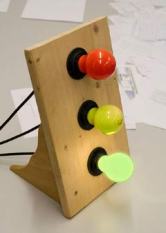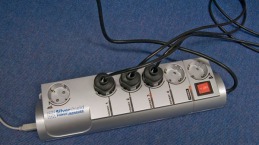The Golight: Tool Support for Test-Driven Development
7 February, 2008
 At the Hasso-Plattner-Institut (HPI) in Potsdam, all Bachelor students have to participate in a software development project in their final year. Said projects are usually issued by industry collaborators, and hence are “real” development tasks that often yield actual products. The different HPI research groups coach the student project groups.
At the Hasso-Plattner-Institut (HPI) in Potsdam, all Bachelor students have to participate in a software development project in their final year. Said projects are usually issued by industry collaborators, and hence are “real” development tasks that often yield actual products. The different HPI research groups coach the student project groups.
This year’s Bachelor project of the Software Architecture Group was issued by CollabNet, the company that spawned Subversion. The students are working on SqueakSVN to make SVN version control and tooling available in Squeak.
Coaching in the Software Architecture Group includes training in agile methodologies, with a strong emphasis on Extreme Programming. Of course, this includes heavy testing.
The students were facing the question of how to make the current project status perceivable in a motivating way. Ideally, the status should be immediately visible when entering the project room in the morning, without the need to start up a Squeak image and run all the tests first.
 They came up with a really nice idea: the “test stoplight”, or, rather, “golight” to make it sound more positive. It’s as simple as this. A wooden board, three red, yellow, and green light bulbs, sockets, power supply lines, and an USB-controlled multiway connector make up the hardware part of the golight.
They came up with a really nice idea: the “test stoplight”, or, rather, “golight” to make it sound more positive. It’s as simple as this. A wooden board, three red, yellow, and green light bulbs, sockets, power supply lines, and an USB-controlled multiway connector make up the hardware part of the golight.
Realizing the software part was also easy. One computer plays the role of a dedicated test server, running a Squeak image. In this image, a process checks out the most recent version of the software from the repository every five minutes, runs all the tests, and switches on the light corresponding to the color of the TestRunner bar. At night, it switches the lights off entirely.
 The software does not even have to know anything about the protocol used to drive the multiway connector. The connector comes with a set of command-line tools that can be run from Squeak using OSProcess. These are currently limited to the Windows operating system, but since controlling the connector is basically about writing some data to a serial connection, it should not be too hard to come up with solutions for other platforms.
The software does not even have to know anything about the protocol used to drive the multiway connector. The connector comes with a set of command-line tools that can be run from Squeak using OSProcess. These are currently limited to the Windows operating system, but since controlling the connector is basically about writing some data to a serial connection, it should not be too hard to come up with solutions for other platforms.
This morning, when I first saw the golight, it was showing green.
Feel free to contact us for detailed building instructions and information related to the software!
Self-Sustaining Systems *Call for Papers*
21 January, 2008

Workshop on Self-sustaining Systems (S3) 2008
May 15-16, 2008
Potsdam, Germany
http://www.swa.hpi.uni-potsdam.de/s3/
Call for papers:
The Workshop on Self-sustaining Systems (S3) is a forum for discussion of topics relating to computer systems and languages that are able to bootstrap, implement, modify, and maintain themselves. One property of these systems is that their implementation is based on small but powerful abstractions; examples include (amongst others) Squeak/Smalltalk, COLA, Klein/Self, PyPy/Python, Rubinius/Ruby, and Lisp. Such systems are the engines of their own replacement, giving researchers and developers great power to experiment with, and explore future directions from within, their own small language kernels.
S3 will be take place May 15-16, 2008 at the Hasso-Plattner-Institute in Potsdam, Germany. It is an exciting opportunity for researchers and practitioners interested in self-sustaining systems to meet and share their knowledge, experience, and ideas for future research and development.
— Invited talk:
Ian Piumarta: Late-bound Object Lambda Architectures (Viewpoints Research Institute, USA)
— Submissions and proceedings:
S3 invites submissions of high-quality papers reporting original research, or describing innovative contributions to, or experience with, self-sustaining systems, their implementation, and their application. Papers that depart significantly from established ideas and practices are particularly welcome.
Submissions must not have been published previously and must not be under review for any another refereed event or publication. The program committee will evaluate each contributed paper based on its relevance, significance, clarity, and originality. Revised papers will be published as post-proceedings in the Springer LNCS series.
Papers should be submitted electronically via EasyChair at
http://www.easychair.org/conferences/?conf=s3 in PDF format.
Submissions must be written in English (the official language of the
workshop) and must not exceed 20 pages. They should use the LNCS format, templates for which are available at http://www.springer.de/comp/lncs/authors.html.
— Venue:
Hasso-Plattner-Institut (Potsdam, Germany)
— Important dates:
Submission of papers: February 15, 2008
Author notification: April 11, 2008
Revised papers due: April 25, 2008
S3 workshop: May 15-16, 2008
Final papers for LNCS post-proceedings due: June 6, 2008
— Chairs:
* Robert Hirschfeld (Hasso-Plattner-Institut Potsdam, Germany)
* Kim Rose (Viewpoints Research Institute, USA)
— Program committee:
* Johan Brichau, Universite Catholique de Louvain, Belgium
* Pascal Costanza, Vrije Universiteit Brussel, Belgium
* Wolfgang De Meuter, Vrije Universiteit Brussel, Belgium
* Stephane Ducasse, INRIA Lille, France
* Michael Haupt, Hasso-Plattner-Institut, Germany
* Robert Hirschfeld, Hasso-Plattner-Institut, Germany
* Dan Ingalls, Sun Microsystems Laboratories, USA
* Martin von Lšwis, Hasso-Plattner-Institut, Germany
* Hidehiko Masuhara, University of Tokyo, Japan
* Ian Piumarta, Viewpoints Research Institute, USA
* David Ungar, IBM, USA
— Registration fees:
Early (until April 18, 2008)
* Regular participants: EUR 160
* Students: EUR 80
Late (after April 18, 2008)
* Regular participants: EUR 170
* Students: EUR 90